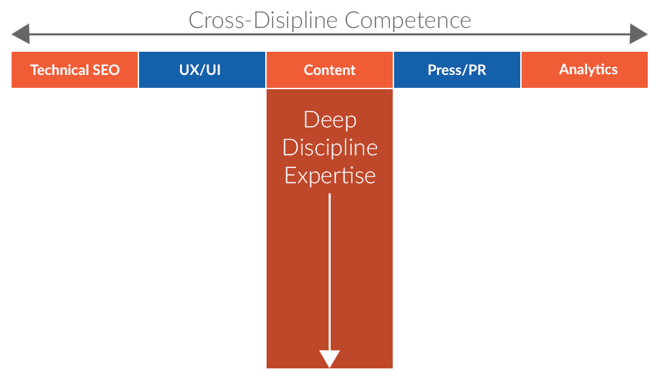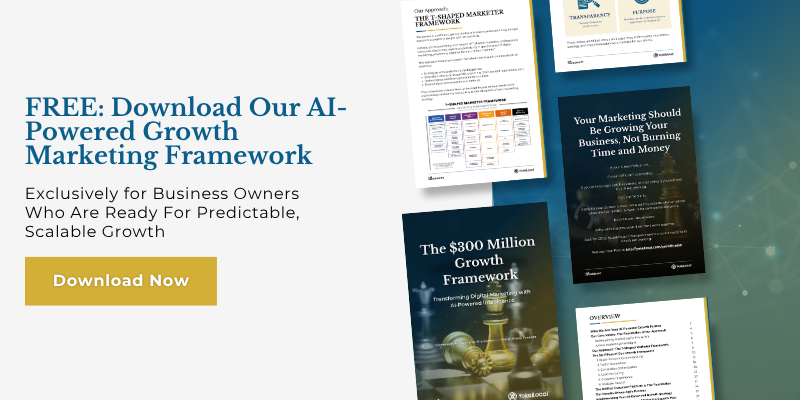As a sole Marketing Director coming into an Agile Marketing environment, it was a change... a MAJOR change...almost life-altering. To compare, it was like going from a singular handshake to a group hug. That was my introduction to the Sprint process
To backup a bit, let’s rewind to December 2015. My previous job had come to an end, as solo marketer for a web tech company. That was for nearly nine years. One company, one singular marketing strategy, mostly created by me.
Within that time period, I saw SEO make way for social media, compete for space with PPC and eventually merge into ‘tactics’ for online marketing.
In this role, it was my responsibility to consolidate and build better brand recognition, drive traffic through multiple channels and educate small business owners on the effectiveness of having an online presence. I used pretty much any and everything available.
The list included:
- Print (magazine ads, phonebook, direct mail)
- Television and radio
- Networking
- Conferences, expos, seminars and webinars
- SEO, SEM, PPC
- Social media (MySpace, Facebook, Twitter and everything inbetween)
- Blogging and content publishing
- Email marketing
Consider it a ‘guerilla’ marketing program where I basically started with nothing and turned it into something. A solid marketing program it was (and still is), reaping benefits for the company.
Enter 2016, a year of transition. Before Yokel Local, I had a ‘transitory’ position that would severely test might patience. Luckily, it was a short transition.
By end of August, I was seated at the table where the magic was about to begin.
The Sprint Process and Agile Project Management
To clarify, the Sprint process is part of what is called in the software development arena, Agile Project Management. In addition to the Sprint, there is also the Scrum.
Breaking it down:
- The Scrum identifies a project’s requirements and needs
- The Sprint is the process of applying solutions to those needs
For the most part, we’ve applied that methodology to our marketing program, although with some modification. Whereas a Sprint in the software development world can last a couple of weeks, we do ours within a 5-hour window per work day. Also, a Sprint team can (and should) have 5-9 members on a team. We’re currently operating with three.
Comparing it to individual project-based approach
About now, you’re wondering, “Why the change to Agile Project Management?” That was my question when I first started. The easiest way to compare is to think individual vs. group. Previously, one person would handle a client’s account with maybe the occasional assist from another team member.
"In essence, we’re ‘sharing the wealth’ among all project participants. In doing so, no one person has to feel overburdened with what can sometimes be a large client workload."
With the Sprint process, all team members are privy to the tasks in a client’s queue. For us, this allows the team to assign the most appropriate team member to the task, as well as allow other team members to provide any input.
In essence, we’re ‘sharing the wealth’ among all project participants. In doing so, no one person has to feel overburdened with what can sometimes be a large client workload.
Spread among the team, a balance is achieved within the workflow. In addition, various viewpoints can open up new ideas, pinpoint issues, troubleshoot problems and drive improvements in workflows.
Is it perfect? No, nothing’s perfect. It’s still a task-based approach. By this I mean, we sometimes focus too much on amassing numbers of tasks. The focus should always be on amassing the number of wins for a client, namely leads.
Yet, even though it’s far from perfect, it is better. And here is how it works.
How we do it
It all starts with the ‘T’ and I don’t mean ‘Ice’ or ‘Mr.’ A T-Shaped Marketer possesses an intermediate level of experience in a wide array of skills, and (near) expert knowledge/experience in one or two.
Let’s look at this illustration. There are roughly five areas where a digital marketer can target for improving online lead generation (mostly through a website but can include paid advertising and social media).

Each block represents a crucial area in online marketing that needs attention as explained below:
- Technical SEO: These are the things Google looks for, eg. keywords, links, titles, meta-descriptions, coding, website speed, etc.
- UX/UI: Abbreviation for User Experience/User Interface. Things that make it easy (or hard) for a website visitor to accomplish, eg. read content, contact the company, make a purchase and even watching a video. If poorly developed, UX/UI can severely limit business growth.
- Content:Without content, a website is just buttons, links and forms. Content provides incentive for search engines to index and rank, for people to research, read and share, and for social media to entertain and inform.
- PR: This is outreach which can use a variety of approaches, eg. press releases, guest blogging, backlinking, paid ad placement and even social media posts.
- Analytics: Data from analytics will inform just about everything you do previously. Analytics will tell you who’s visiting your website, how they got there, what pages they visit and what actions they perform. From this data, you can set up goals (form fill outs, phone calls, purchases) to gauge the success of your website.
As a team, we’re aware of all five areas, but that doesn’t mean we’re experts in all five. At most, each of us has a primary expertise in one and a secondary expertise in another.
As the image shows, we’re competent in all five, but we dive deep on our primary. In doing this, we learn from each other. This is best showcased in our morning review and afternoon wrap-up meetings.
The Daily Process
- First 30 Minutes of the Day
We started everyday with our review of Analytics. From the data, we’d determine the tasks that would produce the most wins. - The Next 4 Hours
This is where the work is done. Once tasks are assigned, we all break off from the group to do the individual work necessary. - Last 30 Minutes of the Day
Here, we discuss and review our individual work, getting input, notating issues, discussing successes, and even compiling tasks for next month’s Sprint.
Once complete, we’re then able to finish the day with any unresolved work, meetings, training or research. As you can see, the ‘Sprint’ process is aptly named.
The Tools
Of course, nothing would get done without the proper tools. As digital marketers, we have a selection of tools necessary for achieving success. Without them, we’re just guessing.
I’ll go on the record and say every marketer has used or is using Google Analytics and Search Console (formerly Webmaster Tools). The combination of these two lays a foundation for acquiring crucial website performance data.
This is where we begin our Sprint’s review meeting in the morning. Search Console will tell us where we’re at. Analytics will tell us where we can and should go.
"Ultimately, if we could patent a process that, when applied, produced the same amazing results every time, our jobs would be a lot easier."
The Ultimate Goal(s)
By implementing the Sprint process, our original goal was to actually accomplish a few things, including:
- Cutting down the time it took to complete tasks
- Quickly highlighting the most important tasks
- Evenly distributing task responsibilities among a team, not an individual
- Targeting the most likely customers that would convert
Ultimately, if we could patent a process that, when applied, produced the same amazing results every time, our jobs would be a lot easier. Currently, there’s a bit of research, experimentation and testing that needs to happen at the beginning of an online marketing campaign.
As each industry is different, this ‘launch phase’ varies from client to client. It’s why some agencies (including Yocal Local) take on clients from industries for which they’ve previously managed campaigns.
The Results
Have we achieved our Goals? Overall, I’d have to say, “Yes.” Can we improve? “Always.” Who wouldn’t want to be faster, get more wins, get more clients, and earn more revenue. That would benefit not only our clients, but Yokel Local as well.
Let’s review:
First, the bad…
As it was a new process, there was a learning curve or ‘breaking in’ period. Starting out, our morning meetups and afternoon wrap ups were long, sometimes painfully long. It was no surprise to anyone though.
The Agile process comes from the Software Development industry. We had to take a process, learn it, and adapt it for Marketing, while still continuing to focus on achieving results for our clients. Those meetings were for discussing what worked and what didn’t.
We also had to learn new tools. Our project management tool, Wrike was newly purchased for the team. Though not wholly unfamiliar, as the staff had previously used similar tools, any new tool has its quirks. Again, adapting tools more prevalently used in other industries, we encountered roadblocks that initially slowed down the process.
For me personally, coming from a previous lone marketer position, I had to not only adjust to a team environment, but to operating within a Scrum process. Not a huge hurdle, but a change nonetheless.
Now, for the good…
Bottom line, the ROI is what matters most. Not only for our clients but for Yokel Local as well. The investment in the right tools, the right staff and the right platforms has greatly enabled the team to produce a return on investment for our clients, ie. get more leads which then can be converted into customers.
Clients don’t care how you do it. Whether we systematically apply best practices in marketing or wave a magic wand, the end result of more customers equaling more business consistently is what they expect.
Where do we go from here?
After a year of implementing, modifying and improving a process, we can now look back at how we got here and where to go.
Some initial observations include:
- A solidary analytics day: Our team leans heavily towards the Right-Brain, ie. creative artists, writers and media specialists. It was hard to go from Analytics in the morning to the tasks which consisted mainly of content creation. In moving analysis of that week’s clients to its own day, it was much easier to jump into creation tasks the other days of the week.
- An expanded outreach program: Backlinks are still relevant but time consuming. Luckily, we invested in a platform at the outset that greatly assisted the team. Pitchbox automated our program to the point we’ve dedicated a sole team member to it.
- Additional team members: As mentioned, typical Scrum teams have 5-9 members and we have three. That’s not to say we couldn’t use more team members. We do have outside resources to draw upon, but in-house availability is much more preferable. As online marketing evolves, and as new clients are acquired, an ever growing and flexible team will be a necessity
The best thing I can say about Agile Marketing and the Scrum process is that it allows our team to perform at the highest level possible for our clients.
For the team, it’s still about the results. Over the past year, we’ve tweaked and tested, adapted and adjusted. We’ll continue to do so. Technology demands it.
New platforms and tools will be introduced. Old platforms and tools will adapt or die. AI continues to evolve and the future of Predictive Marketing is just around the corner.
And our team is ready.














